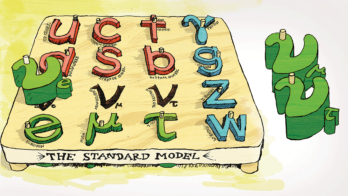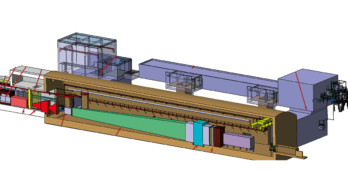A wave of optimism at ICHEP2012.

Image credit: Claudia Marcelloni/ATLAS.
Never before did the International Conference on High-Energy Physics (ICHEP) start with such a bang. Straight after registering on 4 July in Melbourne, participants at ICHEP2012, the 36th conference in the series, were invited to join a seminar at CERN via video link, where they would see the eagerly anticipated presentations of the latest results from ATLAS and CMS. The excitement generated by the evidence for a new boson sparked a wind of optimism that permeated the whole conference. Loud cheers and sustained applause were appropriately followed by the reception to welcome more than 700 participants from around the world, where they could discuss the news over a glass of delicious Australian wine or beer.
As usual, ICHEP consisted of three days of six parallel sessions followed by a rest day and then three days of plenary talks to cover the breadth and depth of particle physics around the world. This article presents only a personal choice of the highlights.
All eyes on the new boson
Talks on the search for the Higgs boson drew huge crowds in the parallel sessions. The discovery of something that looks very much like the Higgs boson raises two pressing questions: what kind of boson was found; and what kind of limits does this discovery impose on the existing models? While the answer to the first question will come only when more data are available, it is already possible to start answering the second question.

Image credit: Jesse Karjalainen.
Sara Bolognesi of Johns Hopkins University presented some interesting preliminary work based on a recently published study in which helicity amplitudes are used to reveal the spin and parity of the new boson. These can be measured through the angular correlations in the decay products. For example, in H → WW decays, when both Ws decay into leptons, the angular separation in the transverse plane can help not only to reduce the background but also to distinguish between spin-parity 0+ and 2+. Likewise, the parity of a spin-0 boson can be inferred from the distribution of the decay angles of H → ZZ → llll. Bolognesi and her colleagues developed a Monte Carlo generator that allows the comparison of any hypothesized spin with data and have made the full analytical computation of the angular distributions that describe the decays H → WW, ZZ and γγ. All that is needed is more data – and the nature of the new particle will be revealed.
Another approach to determine the spin of the new boson consists of studying which decay modes are observed. A Standard Model Higgs boson has spin 0, so it should couple to fermions and vector bosons. Spin 1 is already excluded for the new boson because it could not produce two photons (γγ), each with spin 1. A spin 2 boson could decay into bb– (with an extra spin 1 gluon on board) but not to two τ leptons. So, it was puzzling to hear from Joshua Swanson of the University of Wisconsin Madison that CMS does not observe H → ττ after having analysed the 10 fb–1 at hand from 2011 and 2012. The current analysis is consistent with the background-only hypothesis, yielding an exclusion limit that is 1.06 times the Standard Model production cross-section for mH = 125 GeV. Needless to say, this will be closely monitored as soon as more data become available.

Meanwhile, many theorists and experimentalists are already speculating on the possible impact of the discovery on the current theoretical landscape. Several people showed the effect of all known measurements in flavour physics, direct limits and the new boson mass on existing models. Nazila Mahmoudi of CERN and Clermont-Ferrand University reminded the audience that there is more to supersymmetry (SUSY) than the constrained minimal supersymmetric model (CMSSM). She showed that, assuming that the new particle is a Higgs boson, its mass has a huge impact on the allowed parameter space. Already, several constrained models such as the mSUGRA, mGMSB, no-scale and cNMSSM are severely limited or even ruled out. This impact is, in fact, complementary to direct searches for SUSY. Mahmoudi stressed the importance of going back to unconstrained SUSY models, pointing out that there is still plenty of space for the MSSM model.
So many searches, such little luck
In the search for direct detection of new phenomena, both for exotics and for SUSY, the results were humbling despite the numerous attempts. In the parallel sessions, more than 30 talks were given on SUSY alone,
sometimes covering up to five different analyses. Andy Parker of the University of Cambridge, who reviewed this field, showed how these searches have already covered all of the most obvious places. However, as he reminded the audience, there are still two big reasons to believe in SUSY. First, it provides a candidate for dark matter that has just the right cross-section to be consistent with today’s relic abundance. Second, a light Higgs particle needs this kind of new physics to stabilize its mass. Parker also pointed out that only the third generation of SUSY particles, namely stops and staus, need to be light, a point that Riccardo Barbieri of Scuola Normale Superiore and INFN also stressed in his conference review. For these particles, the current model-independent limits are still rather low, well below 1 TeV, but should improve rapidly with more data.
SUSY could also be hidden if the mass-splitting between gluinos and neutralinos is rather small. In that case there would be very little missing transverse energy (MET), when most analyses have been looking towards large MET. This is the idea behind various scenarios with compressed mass spectra. Or it might be that the SUSY particles are so long lived that they require an adapted trigger strategy because they decay beyond the first layers of the detectors. Searches have been made in all of these directions but without any success so far.

Nevertheless, with the discovery of a new boson, there is much more optimism than a year ago during the European Physical Society conference on High-Energy Physics (EPS HEP 2011), where Guido Altarelli had commented that given no sign for SUSY yet, it was too early for despair but enough for depression. The word of caution that Parker raised, echoing Mahmoudi, provides room for optimism. It is of utmost importance to stay away from the hypotheses of constrained models and to aim instead for the broadest possible scope. SUSY is far from being dead yet and there is plenty of unexplored parameter space, with much of it still containing particles of low mass. As Raman Sundrum of the University of Maryland remarked: “We must not only look for what’s left but rather, what’s right.”
Testing the consistency of the Standard Model with the so-called electroweak fit has been a tradition for all major conferences for the past decade or two and in this ICHEP proved no different – except for a major twist. For the first time, the mass of the newly found boson was used to test if all electroweak measurements (W and Z boson masses, the top-quark mass, single and diboson production cross-sections, lepton universality etc.) could fit together. All of these measurements were reviewed by Joao Barreiro Guimaraes da Costa of Harvard University, culminating with the overall electroweak fit in terms of W-mass versus top-mass space in figure 1. This allows testing of how consistently all of these parameters fit together under the hypothesis that the new boson is the Standard Model Higgs boson (thin blue line) or one associated with MSSM (green band). The blue ellipse shows the current status of the experimental measurements of mt and mW, whereas the black ellipse depicts what will happen if the LHC brings the uncertainty on mW down to 5 MeV – although this will be a great challenge. If the central value remains unchanged, it would bring the Standard Model into difficulty, whereas there will still be plenty of room for the MSSM parameters. One noteworthy result of this global fit is the prediction of the Standard Higgs boson mass at 125.2 GeV when all electroweak parameters are taken into account. Only the direct exclusion limits from the Large Electron–Positron collider and the Tevatron were included.
Dark matter, light neutrinos
“No theories, just guesses for dark matter.” These were the words with which Neal Weiner of New York University summarized the situation on the theory front for dark matter. He explained that, unlike for the Higgs boson, there is currently no theory that allows predictions experimentalists could try to verify. The field is faced with a completely open slate.
If weakly interacting massive particles (WIMPs), a generic class of dark-matter candidates, exist with a mass of around 100 GeV, then some 10 million would go through a person’s hand every second, as Lauren Hsu of Fermilab pointed out during her comprehensive review of direct searches for dark matter. Nevertheless, in contrast to the clarity of Hsu’s presentation, the situation remains extremely confusing. She first reminded the audience of the basics. A WIMP could scatter elastically off a nucleon and the scattering cross-section can be broken into two terms: a spin-independent term (SI), which grows as the square of the atomic mass A; and a spin-dependent term (SD) that scales with the spin of the nucleon.
Currently, xenon-based and cryogenic germanium experiments dominate the field for the SI measurements, while superheated liquid detectors such as Picasso and COUPP are competitive for SD measurements. The XENON100 collaboration’s results for 2011 exceed the sensitivity of other experiments over a range of WIMP masses (new results with 3.5 times better sensitivity appeared just after the conference). SuperCDMS, a germanium-based detector, started operation in March 2012 but first results have still to be released.
Several inconsistencies remain unexplained. In 2008, the DAMA/LIBRA collaboration first reported an annual modulation in event rate that was consistent with dark matter with a statistical significance that now reaches 8.9 σ. This modulation peaks in summer and is at its lowest in winter, making some people suspect backgrounds that are modulated by seasonal changes. COUPP and KIMS, two experiments that use iodine as DAMA/LIBRA does, have now been running for some time. However, their data are not consistent with elastic scattering of WIMPs off iodine, so the mystery continues in terms of what DAMA/LIBRA is seeing. Finally, DM-ICE is a new effort underway in which about 200 kg of sodium-iodide crystals will be deployed within the IceCube detector at the South Pole. One interesting point is that any background tied to seasonal effects will modulate with a different phase in the southern hemisphere.
This is not the only ongoing discrepancy. Two collaborations, CoGeNT and CRESST-II, announced the observation of an annual modulation in low-energy events, with the CRESST-II excess being at 4.2 σ. This contradicts many other results (from CDMS, XENON100, EDELWEISS, ZEPLIN, etc.) where no modulation is observed in low-energy data. The CoGeNT observation was particularly hard to reconcile with the CDMS results because both CoGeNT and CDMS are germanium-based detectors. However, now that the CoGeNT collaboration has modified its background estimates, the data from these two experiments are no longer in conflict. The CRESST team is working on reducing its background, which could help resolve this discrepancy.
The fact that neutrinos have mass proves that there is physics beyond the Standard Model.
Takashi Kobayashi
Moving on to the field of neutrino physics, Takashi Kobayashi of KEK reminded the audience that the mere fact that neutrinos have mass proves that there is physics beyond the Standard Model. These masses induce mixing – in that the different flavours of neutrinos are linear combinations of mass eigenstates. Neutrino mixing is now described by the Pontecorvo–Maki–Nakagawa–Sakata (PMNS) matrix and until recently it remained to be seen if all three flavours participated in the mixing.
Without a doubt the biggest news in neutrino experiments this year came from the Daya Bay experiment’s measurement of the mixing angle between the first and third neutrino-mass eigenstates, Θ13. This is the last ingredient needed to allow future tests of CP-violation in the neutrino sector. T2K had reported the first evidence of νe appearance in 2011, which already implied a non-zero value for θ13. Jun Cao of the Institute of High-Energy Physics, Beijing showed how T2K was then followed by MINOS, Double Chooz, Daya Bay and now RENO, with a first result showing a 4.9 σ deviation from zero for θ13. The Daya Bay group has achieved the best measurement, now with sin22θ13 = 0.089 ± 0.010, a 7.7 σ deviation from zero.
One big remaining area of questions concerns the neutrino-mass hierarchy. Which mass eigenstate is the lightest? Do we have a normal or an inverted hierarchy (figure 2)? As always, much still remains to be done in neutrino physics but, as in the past, it is bound to bring interesting or even surprising results.
Great theoretical developments
Unnoticed by most experimentalists, there have been tremendous developments in the past eight years with scattering amplitude theory. “While experimentalists were busy building the LHC experiments, theorists were improving their understanding of perturbative scattering amplitudes,” said Lance Dixon of SLAC in his overview talk. This has allowed them to “break the dam”, leaving impossibly complex Feynman-diagram-based calculations behind in performing computations at next-to-leading order (NLO). The unprecedented precision achieved has led to the description of complex multijet events, such as those observed in collisions at the Tevatron and the LHC.
These new techniques were developed within the context of the maximally supersymmetric Yang-Mills theory (N = 4 SYM), an exotic cousin of QCD. Currently, complete calculations are possible only for events producing W/Z + jets, which involve at most 110 1-loop diagrams. However, this new technique can tackle the equivalent of 256,265 diagrams. Feynman diagrams are still used but only for the simpler, tree-level processes. One major advantage of scattering amplitudes is that they can recycle tree processes into loops, bringing much simplification to the calculations. This is bringing amazing precision into the new calculations, as Dmitry Bandurin of Florida State University revealed. Now, QCD-inclusive jet cross-sections agree with recent theoretical calculations over 8–9 orders of magnitude and up to jet momenta of 2 TeV, as measurements by the CMS collaboration show (figure 3).

Image credit: Nevereverro/Dreamstime.com.
ATLAS showed the first inclusive jet data at 8 TeV, confirming the expected increase in jet-production rates and reach in transverse momentum. The current level of understanding in jet identification, systematics and jet-energy scale leads in many cases to experimental uncertainties similar to or lower than the theoretical uncertainties. The sensitivity to parton density functions (PDFs) sets the strongest constraint on the gluon PDF and the extraction of the strong coupling constant αs. It also tests αs running up to 400 GeV. The inclusive Z and W results extensively cross-check perturbative QCD calculations, leading to a triumph of NLO, matrix element and parton-shower Monte Carlo predictions. Studies of multiple parton interactions at the Tevatron and the LHC are leading to improved phenomenological nucleon models. All of these results are important for searches for new physics at high energies. The participants witnessed the impressive amount of work accomplished in measuring PDFs, cross-sections, diffractive processes and deep-inelastic scattering, all of which are much needed building blocks for the groundwork that underpins discoveries.
Last summer at EPS-HEP 2011, the LHCb and CMS collaborations created a stir when they presented their first precise search for Bs → μμ decay – a channel that is sensitive to new physics. Now, combining all of the 2011 data for CMS, ATLAS and LHCb, the 95% CL upper limit on this branching fraction is 4.2 × 10–9, closing in on the Standard Model prediction of (3.2 ± 0.2) × 10–9. This new LHC result increases the tension with the result from the CDF experiment at the Tevatron of 13+9–7 × 10–9, which is slightly reduced after including all 10 fb–1 of data.

The LHCb collaboration reported the first observation of a decay with a b → d transition involving a penguin diagram, which makes B+ → πμμ the rarest B decay ever observed. In the Standard Model, it is 25 times smaller than similar decays involving b → s transitions. With 1 fb–1 of collision data, the LHCb experiment obtained 25.3+6.7 –6.4 signal events – a result that is 5.2 σ above background and consistent with the predictions of the Standard Model. The collaboration also reported on the first measurement of CP violation in charmless decays.
At the Tevatron, both the CDF and DØ experiments still see a significant forwards-backwards asymmetry in tt&x#305; production in all channels with a strong dependence on mtt&x#305;, which conflicts with the Standard Model. No such asymmetry is seen by either ATLAS or CMS at the LHC, where it is defined as the asymmetry in the widths of the t and t&x#305; rapidity distributions.
Looking towards the future
CERN’s director-general, Rolf Heuer, concluded the conference by reviewing the future for high-energy-physics accelerators, stating how the LHC results will guide the way at the energy frontier. The current plans for CERN include a long shutdown in 2013–2014 to increase the centre-of-mass energy, possibly to the design value of 14 TeV. This will be followed by two other shutdowns: one in 2018, for upgrades to the injector and the LHC to go to the ultimate luminosity; and one in 2022 for new focusing magnets and crab cavities for high luminosity with levelling, with the humble goal of accumulating about 3000 fb–1 by 2030.
Numerous other plans are in the air, such as a linear collider, where Heuer stressed the importance for the international community to join forces on a single project. “We need to have accelerator laboratories in all regions of the globe planned in an international context, and maintain excellent communication and outreach to show the benefits of basic science to society,” he stressed.
There was not a dull moment at the ICHEP conference in Melbourne, thanks to the efforts of the organizers and their crew. Everyone who joined one of the many possible conference tours on Sunday was treated to views of incredibly beautiful coastlines and native wildlife. The overall experience was well worth the journey.





